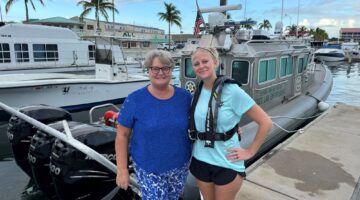Key West officials to tackle increasing city flooding
BY PRU SOWERS
KONK LIFE STAFF WRITER
Whether or not you believe in global warming and rising sea levels, Key West City officials are starting to plan for the worst.
In an extensive climate adaption report presented to city commissioners at their Nov. 19 meeting, Sustainability Coordinator Alison Higgins outlined how the city has worked over the past several years to “harden” local buildings, roads and other infrastructure against storm damage. And she set out what the next steps are, many of which will be expensive to implement.
“The Keys has always been ahead of the rest of Florida in windstorm hardening since the 1980’s. But we barely addressed flooding,” Higgins told the commission.
And flooding is now the immediate issue, with unusually high King Tides flooding low-lying streets for longer than normal periods this year. Key West has been tracking sea levels since 1846. During that time, water levels have risen at an average annual rate of 2.4 millimeters.
“That’s roughly just under an inch a decade or about five inches every 50 years. But that rate is changing,” Higgins said, rising at an even faster level. Studies indicate regional sea levels will rise four to eight inches by 2030. As a result, the city needs to stay ahead of the potential danger.
Towards that end, Key West has formed a new adaption planning team, chaired by Higgins. The heads of several city departments, including building, planning and engineering, are on the committee, as well. The first goal is to assess the vulnerability of Key West buildings and public services to flooding.
“We’ll look at flood zones, [building] life expectancy, materials, needs, etc. And then assess the cost, put it in the budgeting and if warranted, lobby at state and federal levels to increase funding and assistance for these efforts,” Higgins said.
That assessment should be completed by next summer, when the city begins budget planning for the 2020-2021 fiscal year. But is that soon enough, asked Mayor Teri Johnston?
“We’re getting ready to go into a pavement [repair and maintenance] plan. Clearly, we’re a little concerned about not raising the roads that flood right now,” Johnston said.
But it’s not easy – albeit expensive – to raise a road, said Kelly Crowe, Key West City Engineer. It can cost up to $10 million to raise one mile of road, versus the average $1 million per mile to repave an existing roadway. And if you raise one road, what happens to connecting streets and the property adjacent to that road?
“We don’t want to create ponding situations. We don’t want to create adverse flooding impacts. We wouldn’t necessarily raise one without connecting another,” Crowe said.
There may be other less expensive flooding solutions that city engineers want to try first, before resorting to lifting roadways, said Key West Director of Engineering Steve McAlearney. There are tidal valves that can close storm drains during high tides, helping keep water from backing up into the streets. There are wells that can be dug around low-lying areas, giving water a place to go during high tides. City engineers plan to install multiple flood valves around the intersection of Simonton and Front streets to reduce flooding as an initial step.
“There are strategies to go to first, without raising [streets],” McAlearney said, adding, “I think we need to check these things first to see if they work. If they do, that will save us a lot of money in the short term.”
[livemarket market_name="KONK Life LiveMarket" limit=3 category=“” show_signup=0 show_more=0]







No Comment